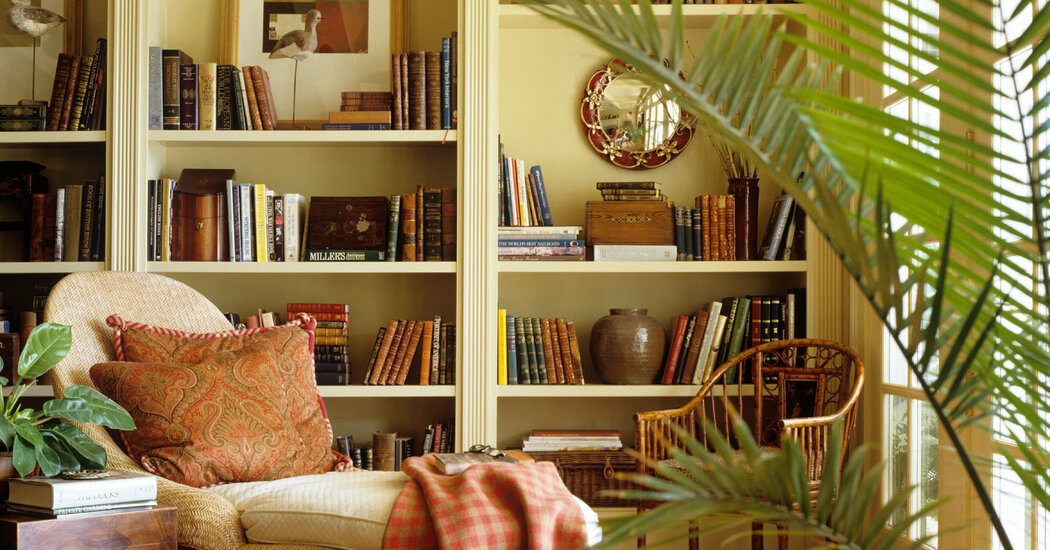
A TikTok home-décor trend has irked some bibliophiles.
When it comes to aesthetic trends, social media loves a catchy name.
Cottagecore. Dark academia. Eclectic grandpa.
Now there’s a new entry to the canon: bookshelf wealth.
On TikTok and other digital platforms, there has lately been much ado about people who own a great number of books and — this is critical — have managed to stage them in a pleasing manner.
If you’ve ever seen a Nancy Meyers movie, the look might ring a bell. Warm and welcoming. Polished, but not stuffy. A bronze lamp here. A vintage vase there (with fresh-cut flowers, of course). Perhaps there is a cozy seating area near the floor-to-ceiling display, with an overstuffed couch topped with tasteful throw pillows.
Kailee Blalock, an interior designer in San Diego, posted a video to TikTok last month that sought to define bookshelf wealth and school viewers in achieving the aesthetic in their own homes.
“These aren’t display books,” Ms. Blalock, 26, cautions in the video, which has been viewed over 1.3 million times. “These are books that have actually been curated and read.”
This literary look, she went on to say, goes well with pictures hung willy-nilly on the walls, sometimes even partly blocking the shelves, as well as mismatched fabric patterns and a bit of clutter.
A Quick Guide to Bookshelf Wealth
@houseofhive Bookshelf Wealth, what it is and how to achieve it #greenscreen #bookshelfwealth #interiordesign #designtok #2024designtrends ♬ original sound – House of Hive Design Co
In an interview, Ms. Blalock expanded on her advice. “I think to really achieve the look and the lifestyle, someone has to be an avid reader and has to appreciate the act of collecting things, especially art and sculpture,” she said.
Though Ms. Blalock did not originate the term “bookshelf wealth,” her video has spurred plenty of online discussion. “The day I ‘cultivate’ books instead of buying what I like to read is the day I’ll know I’ve truly failed as a human,” one user commented. Others remarked how bookshelf wealth was less about reading and more about regular old wealth.
Breana Newton, a legal coordinator in Princeton, N.J., who posts regularly about books on TikTok, was one of the people who responded to Ms. Blalock’s video. “I am going to show you bookshelf wealth,” Ms. Newton, 33, says in a video of her own. “Ready?”
She then gives viewers a brief tour of her home, showing books everywhere — on shelves, in overflow piles here and there, and strewed across the bed. Absent is the sense that the rooms have been staged, or that the books were bought with the consideration of how they would look on Instagram.
In an interview, Ms. Newton said that she worried trends like bookshelf wealth encourage overconsumption. This year, she added, she is trying not to buy any new books.
Another critic of the trend, Keila Tirado-Leist, said in a reaction video: “Who does it benefit to constantly have to name and qualify and attach wealth to any kind of style or home-décor aesthetic?”
Ms. Tirado-Leist, a lifestyle content creator in Madison, Wis., likened bookshelf wealth to “quiet luxury” and “stealth wealth,” styles that have recently made social media waves.
Still, she was understanding that what drives a home-décor trend like this one is a desire to create a home that feels, well, homey. In another video, she described the idea of layering — that is, slowly acquiring pieces and building up to a finished look, rather than trying to buy a bunch of things all at once in an effort to chase a trend.
“Styling a home takes time,” Ms. Tirado-Leist said.
Another TikTok user put it more bluntly in a response to Ms. Blalock’s video: “Bookshelf wealth does not mean you have books. It means you have built-ins.”